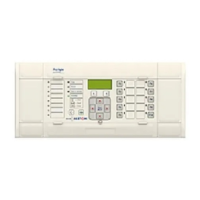CM
4.2 With the relay energised
The following group of tests verifies that the relay hardware and software is functioning
correctly and should be carried out with the auxiliary supply applied to the relay.
The current and voltage transformer connections must remain isolated from the relay for
these checks. The trip circuit should also remain isolated to prevent accidental operation of
the associated circuit breaker. The InterMiCOM communication channel (where fitted) should
be disconnected to prevent the remote end relay being affected during the tests.
4.2.1 Watchdog contacts
Using a continuity tester, check the watchdog contacts are in the states given in Table 2 for
an energised relay.
4.2.2 Date and time
Before setting the date and time, ensure that the factory-fitted battery isolation strip, that
prevents battery drain during transportation and storage, has been removed. With the lower
access cover open, presence of the battery isolation strip can be checked by a red tab
protruding from the positive side of the battery compartment. Whilst lightly pressing the
battery, to prevent it from falling out of the battery compartment, pull the red tab to remove
the isolation strip.
The date and time should now be set to the correct values. The method of setting will
depend on whether accuracy is being maintained via the optional Inter-Range
Instrumentation Group standard B (IRIG-B) port on the rear of the P741 relay.
4.2.2.1
With an IRIG-B signal for Central Unit (P741) only
If a satellite time clock signal conforming to IRIG-B is provided and the P741 relay has the
optional IRIG-B port fitted, the satellite clock equipment should be energised.
To allow the relay’s time and date to be maintained from an external IRIG-B source cell
[DATE and TIME, IRIG-B Sync] must be set to ‘Enabled’.
Ensure the relay is receiving the IRIG-B signal by checking that cell [DATE and TIME,
IRIG-B Status] reads ‘Active’.
Once the IRIG-B signal is active, adjust the time offset of the universal co-ordinated time
(satellite clock time) on the satellite clock equipment so that local time is displayed.
Check the time, date and month are correct in cell [DATE and TIME, Date/Time]. The IRIG-B
signal does not contain the current year so it will need to be set manually in this cell.
In the event of the auxiliary supply failing, with a battery fitted in the compartment behind the
bottom access cover, the time and date will be maintained. Therefore, when the auxiliary
supply is restored, the time and date will be correct and not need to be set again.
To test this, remove the IRIG-B signal, then remove the auxiliary supply from the relay.
Leave the relay de-energised for approximately 30 seconds. On re-energisation, the time in
cell [DATE and TIME, Date/Time] should be correct.
Reconnect the IRIG-B signal.
The P741 will synchronise all peripheral units (P742/P743) every 10s and during the
powering on of the scheme.

